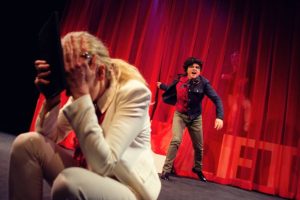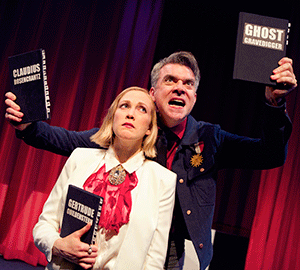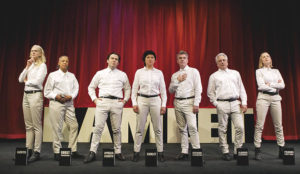Long Live the Revolution: a review of HAMLET at Shotgun Players
April 30, 2016 § Leave a Comment
A generation ago, there were two surefire claims to bragging rights among serious Shakespeare playgoers: that you had personally seen one or both of the two most revolutionary productions of the 20th Century–Peter Brook’s Midsummer and Steven Berkoff’s Hamlet.
Brook’s white box set became famous, and going even further towards stripping a play down to its essence, Berkoff reduced Hamlet’s spectacle to a single taped white line across the floor, inspiring an entire generation to a more visceral and less pictorial approach. For those who (like me) missed those heady days, the spiritual successor to Steven Berkoff’s famously minimalist production has come to Berkeley’s Shotgun Players.

El Beh as Hamlet and Beth Wilmurt as Gertrude. (I think that is David Sinaiko playing the dying Polonius just visible through the curtain. ) This is not the same casting configuration I saw, as explaned below…
Shotgun Shakespeare
Shotgun is celebrating its 25th anniversary season, and it is hard to imagine any production that could better convey their aesthetic, showcase their artists and speak to their particular audience than their current offering. Directed by long-time company member Mark Jackson*, the production features a four-woman/three-man, vaguely androgynous, multi-ethnic ensemble presenting a considerably shortened–and therefore very fast moving–version of the work. Nina Ball’s set is a bi-level black platform with a layer of intense red curtains behind each level, and six chairs that mostly live along the side walls of the theatre but occasionally make their way onstage as a throne, a bed or a grave.
Jackson’s staging is clean, and in his signature style, very physical. Isolated iconic gestures associated with each character are the dominant motif. Christine Crook’s costumes are simple, suggestive bits and pieces – jeans, sweaters, jackets, coveralls, and a long, flowing blouse for Ophelia. Heather Basarab’s lights (and deep shadows) are intense and often directionally moody. Matt Stines’ blatantly theatrical sound design is purposely foregrounded, most prominently in the long fencing scene at the end of the play–noisily fought with invisible rapiers. Perhaps the most noticeable visual element of the production is that all the actors carry (but never consult) scripts with them, which they use as props whenever possible.

Kevin Clarke and Megan Trout, as Hamlet upbraiding his mother with the images of his father and uncle. (This is also not the cast configuration I saw.)
Audience Partnership
As one might expect of Shotgun, the work is raw, rough, and unsentimental. Berkeley’s sophisticated audience is called upon both intellectually and imaginatively to extend the performance far beyond what is materially presented in front of them. The cutting is severe. The opening scenes on the battlements, the traveling players, Fortinbras, and most of Act IV all disappear.
As is often the case with minimalist productions, so much is gone that the production is probably incomprehensible to anyone who does not already know the plot–but it is a safe bet that virtually no one in Shotgun’s audience has trouble filling in the rather massive holes in the remaining narrative. As but one example, Hamlet’s soliloquy that begins “Oh, what a rogue and peasant slave…” is (mostly) retained, but since it does not follow on the appearance of the troupe of traveling players, Hamlet’s musing on surface appearances versus deep feelings now references the real actors in Shotgun’s production instead of the pretend ones visiting Elsinore. That is a logical leap a couple of levels of metaphor removed from the play as traditionally presented, and probably can’t be made unless you know the original context–but it tells you a lot about Shotgun that it presented no problem to anyone on the night I saw the show. (The actual performance of the players’ The Mousetrap, for those who are worried, is reassigned to Hamlet and Ophelia.)
Given the severity of the cutting, reassignment of lines, and occasional rearrangements of the order of speeches, I would have preferred a little more dramaturgical expertise behind the cast’s collective cutting. I might personally have encouraged consideration of the otherwise dubious First Quarto’s placement of “To be or not to be,” which makes far more sense when located much earlier in the show, as Q1 has it, especially when it is laid as bare as it is in this much-shortened version. It is part of the dedication to the ensemble, however, that dictates an equal voice for the actors in matters like this–matters which are usually deferred to “experts” and decided long before the actors are even cast.
Shakespeare Roulette
The production would be interesting enough if it was conventionally cast and presented, but it has an extra level of artistic risk and emotional excitement because it performed in what the company calls “roulette style.” All seven cast members (and an understudy) have memorized the entire play, and just before the performance a random drawing determines which actor will play which part(s) that night. As it happens, I saw the closest fit to a traditional Hamlet (actor Nick Medina) play the title role on the night I attended, and perhaps that made it more easily digestible, but I also saw company member Kevin Clarke play Ophelia – a sensitive and beautiful performance despite the fact that he made almost no attempt to impersonate a young woman. The dynamics of the tragedy emerge from the circumstances, not from the actors’ appearances and personalities. Of course, no two performances are even remotely the same.

Beth Wilmurt, Cathleen Riddley, Nick Medina, El Beh, Kevin Clarke, David Sinaiko, and Megan Trout prepare to pick their roles for the night in “Hamlet” at Shotgun Players. (Photo by Pak Han)
Not every artist would be willing to place him/herself under this pressure, but it is typical of Shotgun’s players that they are attracted to the unorthodox and the risky. On the night I saw the show, El Beh (last seen at Shotgun as Emily in Our Town) played Laertes, and Cathleen Riddley played Claudius (and Rosencrantz). That two women of color were randomly placed in the roles of the two violent male antagonists was, to say the least, illuminating. The youngest person in the cast, Megan Trout, drew the oldest characters: the Ghost/Gravedigger. The evening was filled out with Beth Wilmurt as Gertrude/Guildenstern and David Sinaiko as Polonius/Osric.
The particular performance that I saw was not word perfect, but the minor wobbles and unapologetic prompting did not dull the sense of danger emerging from a previously staged, but still almost improvisatory, first “run-through” in this configuration. Like the rehearsal period that actors so cherish, discoveries were being made right on the spot, and that forced both actors and audience members to pay close attention.
Designed for Multiple Viewings
This is not what one of my colleagues calls “gift shop Shakespeare.” It is not pretty, celebrity studded, or made topical. Jackson and his cast are excavating the essential text from under a lot of accumulated baggage, and what emerges is often highly original and gut wrenching. (I was particularly struck by the stunning manner in which Gertrude’s strangely incongruous description of Ophelia’s death was recontextualized in a way that finally made sense.) That it can also be, from moment-to-moment, a bit hit-or-miss is beside the point. After all, you can always come back to another performance–a possibility made easy because Shotgun sells tickets in three performance packages–to see it all handled differently another night. From what I could ascertain at my particular performance, a lot of patrons were seeing the production for a second time. It is a trend that I predict will continue with this fascinating production as it continues its run, as part of a season-long repertory, through January 2017.

*As a matter of full disclosure, (although we have never worked together directly) both Mark Jackson and Matt Stines have been my colleagues at San Francisco State University, and Megan Trout is one of the program’s graduates.
Leave a Reply